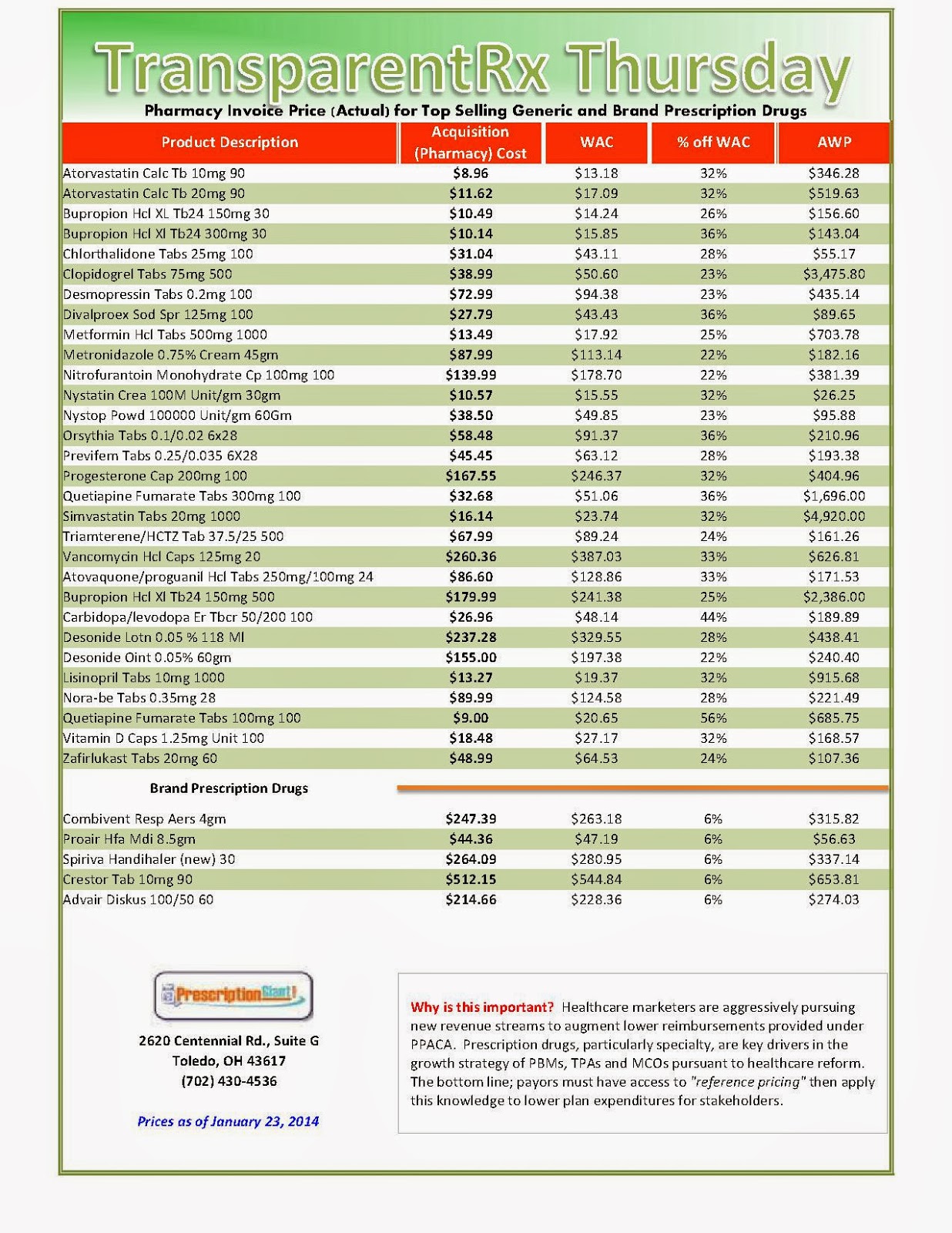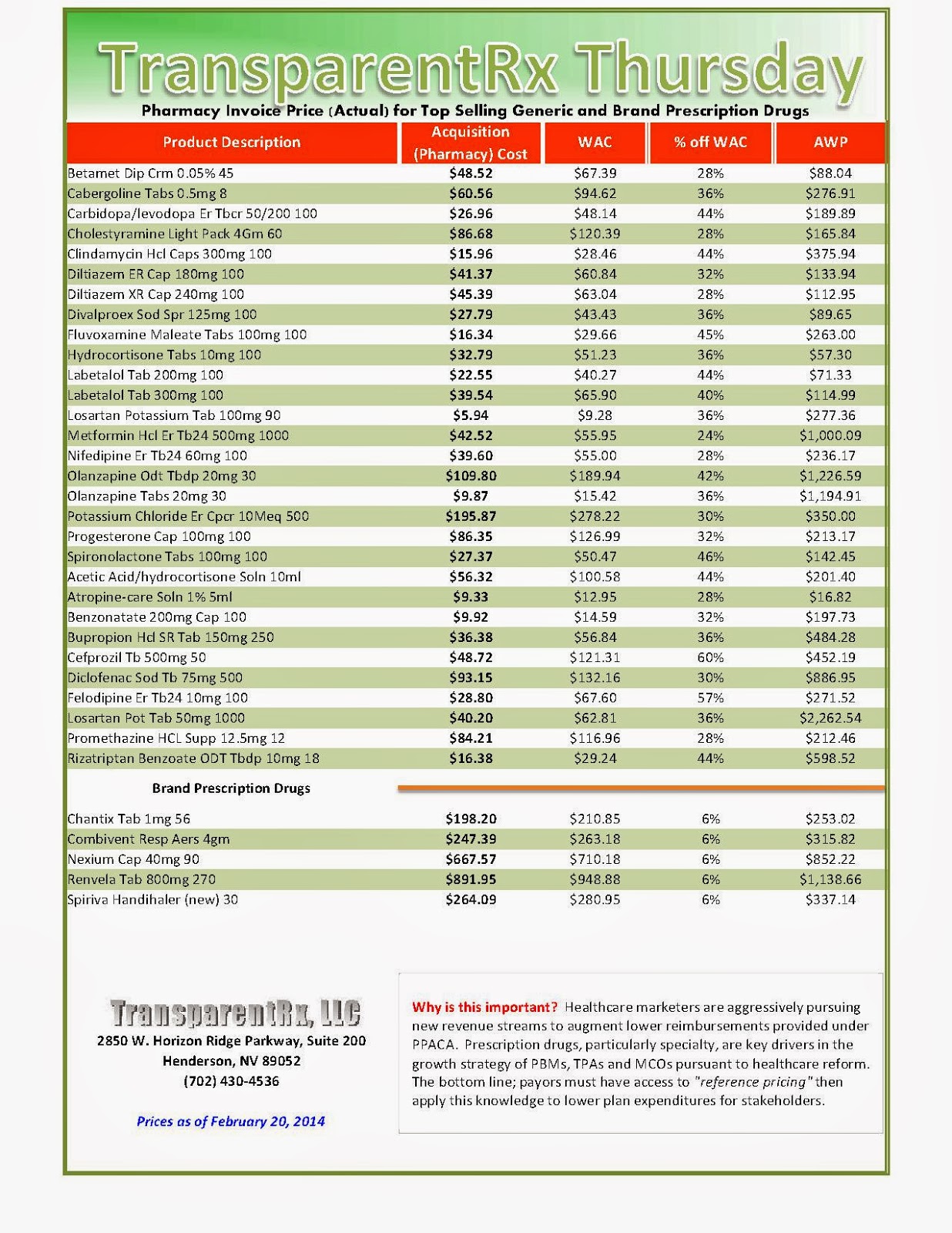Reference Pricing: Pharmacy Invoice Cost (ACTUAL) for Top Selling Generic and Brand Prescription Drugs
The costs shared below are what our pharmacy actually pays; not AWP, MAC or WAC. The bottom line; payers must have access to “reference pricing.” Apply this knowledge to hold PBMs accountable and lower plan expenditures for stakeholders.
| How to Determine if Your Company [or Client] is Overpaying |
Step #2: In addition, request an electronic copy of all your prescription transactions (claims) for the billing cycle which coincides with the date of your price list.
Step #3: Compare approximately 10 to 20 prescription claims against the price list to confirm contract agreement. It’s impractical to verify all claims, but 10 is a sample size large enough to extract some good assumptions.
Step #4: Now take it one step further. Check what your organization has paid, for prescription drugs, against our pharmacy cost then determine if a problem exists. When there is a 5% or more price differential (paid versus actual cost) we consider this a problem.
When better pricing is discovered the contract language should stipulate the client be indemnified. Do not allow the PBM to limit the market check language to a similar size client, benefit design and/or drug utilization. In this case, the market check language is effectually meaningless.
Reference Pricing: Pharmacy Invoice Cost (ACTUAL) for Top Selling Generic and Brand Prescription Drugs
The costs shared below are what our pharmacy actually pays; not AWP, MAC or WAC. The bottom line; payers must have access to “reference pricing.” Apply this knowledge to hold PBMs accountable and lower plan expenditures for stakeholders.
| How to Determine if Your Company [or Client] is Overpaying |
Step #2: In addition, request an electronic copy of all your prescription transactions (claims) for the billing cycle which coincides with the date of your price list.
Step #3: Compare approximately 10 to 20 prescription claims against the price list to confirm contract agreement. It’s impractical to verify all claims, but 10 is a sample size large enough to extract some good assumptions.
Step #4: Now take it one step further. Check what your organization has paid, for prescription drugs, against our pharmacy cost then determine if a problem exists. When there is a 5% or more price differential (paid versus actual cost) we consider this a problem.
When better pricing is discovered the contract language should stipulate the client be indemnified. Do not allow the PBM to limit the market check language to a similar size client, benefit design and/or drug utilization. In this case, the market check language is effectually meaningless.
Limited Pharmacy Networks are Changing Employer Sponsored Prescription Drug Benefits
Creation of Narrow Pharmacy Networks to Control Costs
Increasingly, PBMs are using more tightly controlled pharmacy network models to achieve additional drug spending savings. Narrow networks are not a new concept in healthcare; this is the logic behind preferred provider organizations (PPOs) and health maintenance organizations (HMOs) where preferred or exclusive providers agree to special pricing terms, hoping to realize increased volume.
Narrow pharmacy network. With narrow networks, consumers receive financial incentives to use particular pharmacies that offer lower costs and/or give payers greater control. Pharmacies that participate in narrow networks are willing to accept reduced reimbursement rates in order to boost store traffic. There are different types of narrow networks. Two of the most common terms you hear are:
- Preferred pharmacy network. Consumers can choose any pharmacy in their plan’s network, but pay a lower out-of-pocket cost when they choose to get their prescription filled from preferred pharmacies — which usually represent 20% to 50% of all retail pharmacies — and pay more out of pocket if they buy from a non-preferred pharmacy. For example, a consumer may have no co-payment on certain drugs if a prescription is filled at a preferred pharmacy and a $5 copay if filled at a non-preferred pharmacy in the network.
- Limited pharmacy network. In this more restrictive model, consumers can only use the specific pharmacies or dispensing formats designated as part of the payer’s limited network. The model gives payers the greatest degree of economic control, as they will only include pharmacies with the lowest costs and highest service levels. Limited networks are typically 50% to 80% smaller than an open network, usually having fewer than 20,000 pharmacies.
Reference Pricing: Pharmacy Invoice Cost (ACTUAL) for Top Selling Generic and Brand Prescription Drugs
The costs shared below are what our pharmacy actually pays; not AWP, MAC or WAC. The bottom line; payers must have access to “reference pricing.” Apply this knowledge to hold PBMs accountable and lower plan expenditures for stakeholders.
Pharmacy Network Reimbursement Rates
 |
| PBM Provider Agreement
There are far too many variables to address in PBM contracts for payers to achieve any reasonable level of transparency. The solution; partner with only those PBMs willing sign and act as a fiduciary.
|
Reference Pricing: Pharmacy Invoice Cost (ACTUAL) for Top Selling Generic and Brand Prescription Drugs
The costs shared below are what our pharmacy actually pays; not AWP, MAC or WAC. The bottom line; payers must have access to “reference pricing.” Apply this knowledge to hold PBMs accountable and lower plan expenditures for stakeholders.
_1.jpg) |
|
As of 1/30/2014 – Published Weekly on Thursdays
Step #1: Obtain a price list for generic prescription drugs from your broker, TPA, ASO or PBM every month.
Step #2: In addition, request an electronic copy of all your prescription transactions (claims) for the billing cycle which coincides with the date of your price list. Step #3: Compare approximately 10 to 20 prescription claims against the price list to confirm contract agreement. It’s impractical to verify all claims, but 10 is a sample size large enough to extract some good assumptions. Step #4: Now take it one step further. Check what your organization has paid, for prescription drugs, against our pharmacy cost then determine if a problem exists. When there is a 5% or more price differential (paid versus actual cost) we consider this a problem. Multiple price differential discoveries means that your organization or client is likely overpaying. REPEAT these steps once per month.
— Tip —
Always include a semi-annual market check in your PBM contract language. Market checks provide each payer the ability, during the contract, to determine if better pricing is available in the marketplace compared to what the client is currently receiving.
When better pricing is discovered the contract language should stipulate the client be indemnified. Do not allow the PBM to limit the market check language to a similar size client, benefit design and/or drug utilization. In this case, the market check language is effectually meaningless. |
Reference Pricing: Pharmacy Invoice Cost for Top Selling Generic and Brand Prescription Drugs
The costs shared below are what our pharmacy actually pays; not AWP, MAC or WAC. The bottom line; payers must have access to “reference pricing.” Apply this knowledge to hold PBMs accountable and lower plan expenditures for stakeholders.
_1.jpg) |
|
As of 1/23/2014 – Published Weekly on Thursdays
Step #1: Obtain a price list for generic prescription drugs from your broker, TPA, ASO or PBM every month.
Step #2: In addition, request an electronic copy of all your prescription transactions (claims) for the billing cycle which coincides with the date of your price list. Step #3: Compare approximately 10 to 20 prescription claims against the price list to confirm contract agreement. It’s impractical to verify all claims, but 10 is a sample size large enough to extract some good assumptions. Step #4: Now take it one step further. Check what your organization has paid, for prescription drugs, against our pharmacy cost then determine if a problem exists. When there is a 5% or more price differential (paid versus actual cost) we consider this a problem. Multiple price differential discoveries means that your organization or client is likely overpaying. REPEAT these steps once per month.
— Tip —
Always include a semi-annual market check in your PBM contract language. Market checks provide each payer the ability, during the contract, to determine if better pricing is available in the marketplace compared to what the client is currently receiving.
When better pricing is discovered the contract language should stipulate the client be indemnified. Do not allow the PBM to limit the market check language to a similar size client, benefit design and/or drug utilization. In this case, the market check language is effectually meaningless. |
The Pharmacy Benefits Manager RFP; 7 Contract Tips for a Cost Efficient Drug Benefit Design

- Skip the RFP as it is largely a waste of time and money. Instead draft an airtight FIDUCIARY contract and put it out for bid
- Acquire “reference pricing” AND relentlessly measure cost performance
- Write meaningful financial and performance guarantees
- Mandate full transparency and complete audit rights
- Create market check and carve-out rights that currently don’t exist in almost all PBM contracts
- Shorten contracts (to 2 years) and include favorable contract termination rights
- Eliminate rebate and/or savings program loopholes
- Go to the previous page
- 1
- …
- 124
- 125
- 126
- 127
- 128
- 129
- 130
- …
- 138
- Go to the next page

_1.jpg)
_1.jpg)
_1.jpg)
